LMR-195 vs RG58 Cable
The importance of using a low-loss antenna cable is often overlooked. The signal loss in an antenna cable (dB) can cause a huge reduction in efficiency. For every 3 dB lost in the antenna cable, the transmitter power will be reduced to half before reaching the antenna. Many of the antenna cables found on the market are manufactured with RG58 cable. At Infinite Cables, we have standardized on Times Microwave LMR-195 simply because of its low-loss characteristics. Please refer to the dB loss chart below. As you can see, the LMR-195 cable out performs RG58 cable by a significant amount.
|
|
LMR-195 dB Loss @ Frequency below
|
| Length
|
1 GHz
|
2 GHz
|
2.4 GHz
|
4 GHz
|
5.7 GHz
|
| 1.5ft |
0.18 dB
|
0.25 dB
|
0.28 dB
|
0.37 dB
|
0.44 dB
|
| 3ft |
0.35 dB
|
0.51 dB
|
0.56 dB
|
0.73 dB
|
0.89 dB
|
| 6ft |
0.71 dB
|
1.01 dB
|
1.12 dB
|
1.47 dB
|
1.78 dB
|
| 10ft |
1.18 dB
|
1.69 dB
|
1.86 dB
|
2.44 dB
|
2.96 dB
|
| 15ft |
1.76 dB
|
2.53 dB
|
2.79 dB
|
3.67 dB
|
4.44 dB
|
| 25ft |
2.94 dB
|
4.22 dB
|
4.65 dB
|
6.11 dB
|
7.41 dB
|
| |
RG58 dB Loss @ Frequency below
|
|
Length
|
1 GHz
|
2 GHz
|
2.4 GHz
|
4 GHz
|
5.7 GHz
|
| 1.5ft |
0.23 dB
|
0.34 dB
|
0.37 dB
|
0.50 dB
|
0.61 dB
|
| 3ft |
0.46 dB
|
0.67 dB
|
0.74 dB
|
1.00 dB
|
1.22 dB
|
| 6ft |
0.92 dB
|
1.35 dB
|
1.49 dB
|
1.99 dB
|
2.45 dB
|
| 10ft |
1.53 dB
|
2.24 dB
|
2.48 dB
|
3.32 dB
|
4.08 dB
|
| 15ft |
2.30 dB
|
3.36 dB
|
3.72 dB
|
4.98 dB
|
6.12 dB
|
| 25ft |
3.83 dB
|
5.61 dB
|
6.21 dB
|
8.30 dB
|
10.20 dB
|
LMR-400 vs RG8 Cable
LMR-400 is a drop in replacement for RG8 coaxial cable with the exception that LMR-400 has a lower dB loss than RG8 cable. Please refer to the dB loss chart below. As you can see, the LMR-400 cable out performs RG8 cable by a significant amount.
|
|
LMR-400 dB Loss @ Frequency below
|
| Length
|
1 GHz
|
2 GHz
|
2.4 GHz
|
4 GHz
|
5.7 GHz
|
| 6ft |
0.25 dB
|
0.36 dB
|
0.40 dB
|
0.53 dB
|
0.64 dB
|
| 10ft |
0.41 dB
|
0.60 dB
|
0.66 dB
|
0.88 dB
|
1.07 dB
|
| 15ft |
0.62 dB
|
0.90 dB
|
0.99 dB
|
1.32 dB
|
1.61 dB
|
| 25ft |
1.03 dB
|
1.50 dB
|
1.65 dB
|
2.19 dB
|
2.68 dB
|
| 35ft |
1.44 dB
|
2.10 dB
|
2.32 dB
|
3.07 dB
|
3.75 dB
|
| 50ft |
2.06 dB
|
2.99 dB
|
3.31 dB
|
4.39 dB
|
5.36 dB
|
| 75ft |
3.10 dB
|
4.49 dB
|
4.96 dB
|
6.58 dB
|
8.04 dB
|
| 100ft |
4.13 dB
|
5.99 dB
|
6.61 dB
|
8.77 dB
|
10.71 dB
|
| 125ft |
5.16 dB
|
7.49 dB
|
8.27 dB
|
10.97 dB
|
13.39 dB
|
|
|
RG8 dB Loss @ Frequency below
|
| Length
|
1 GHz
|
2 GHz
|
2.4 GHz
|
4 GHz
|
5.7 GHz
|
| 6ft |
0.44 dB
|
0.66 dB
|
0.74 dB
|
1.03 dB
|
1.30 dB
|
| 10ft |
0.73 dB
|
1.11 dB
|
1.24 dB
|
1.71 dB
|
2.16 dB
|
| 15ft |
1.09 dB
|
1.66 dB
|
1.86 dB
|
2.57 dB
|
3.24 dB
|
| 25ft |
1.28 dB
|
2.77 dB
|
3.10 dB
|
4.28 dB
|
5.40 dB
|
| 35ft |
2.55 dB
|
3.87 dB
|
4.33 dB
|
5.99 dB
|
7.56 dB
|
| 50ft |
3.65 dB
|
5.53 dB
|
6.19 dB
|
8.56 dB
|
10.80 dB
|
| 75ft |
5.47 dB
|
8.30 dB
|
9.29 dB
|
12.84 dB
|
16.20 dB
|
| 100ft |
7.3 dB
|
11.06 dB
|
12.38 dB
|
17.12 dB
|
21.60 dB
|
| 125ft |
9.12 dB
|
13.83 dB
|
15.48 dB
|
21.40 dB
|
27.00 dB
|
RF Connector Index
(scroll down to view SMA, BNC, TNC and N-Type pictures)
SMA Coax Low-Loss 50 ohm Antenna Cables
The SMA connector (Sub Miniature Version A) was developed back in the 1960's. Today, it is commonly used in the computer world on wireless access points, connecting them to 50 ohm antennas.
SMA connectors come in a variety of flavors. Here is a brief list:
SMA Male
SMA Female
SMA(RP) Male - Reverse Polarity
SMA(RP) Female - Reverse Polarity
SMA Male - Right Angle
An SMA male connector has a male center pin and a male outer shell. An SMA Male-Reverse Polarity connector, has a FEMALE center pin and a MALE outer shell. It can get a bit confusing when trying to determine exactly which one you need. See the pictures for a better understanding.
|
SMA Male Connector
|
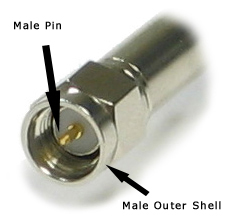 |
|
SMA-RP (Reverse Polarity)
Male Connector
|
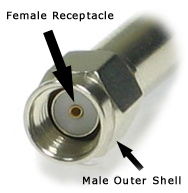 |
|
SMA Male Right Angle Connector
|
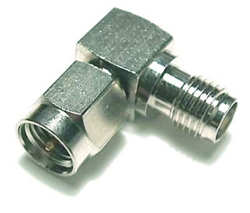 |
|
SMA Female Connector
|
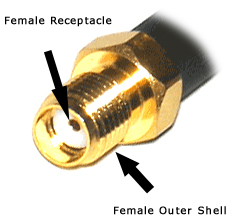 |
|
SMA-RP (Reverse Polarity) Female Connector
|
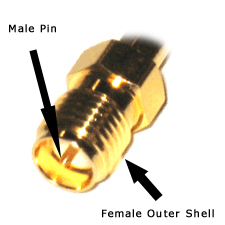 |
Some manufacturers which use SMA connections on some of their Wireless access point products are:
3com
Belkin
Blitzz
Clarion
Compaq
D-Link
Intel
Linksys
Motorola
Samsung
Siemens
SMC
US. Robotics
TNC Coax Low-Loss 50 ohm Antenna Cables
The TNC Connector (Threaded Neill-Concelman) was developed in the early 1950's. It has been used in a variety of radio and wired applications over the years. Most recently, it too has been used in the computer world on wireless access points, connecting them to 50 ohm antennas.
The most common configurations of TNC connectors are as follows:
TNC Male
TNC Female
TNC (RP) Male - Reverse Polarity
TNC (RP) Female - Reverse Polarity
Much like SMA connectors, TNC reverse polarity connectors have a female center pin inserted into a male outer shell, and a male pin inserted into a female outer shell. Please see pictures below.
|
TNC Male Connector
|
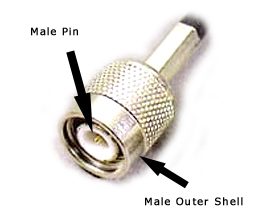 |
|
TNC-RP (Reverse Polarity) Male Connector
|
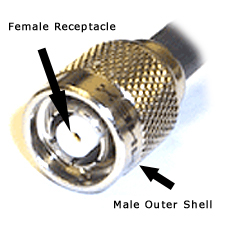 |
|
TNC Female Connector
|
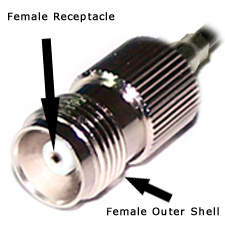 |
|
TNC-RP (Reverse Polarity) Female Connector
|
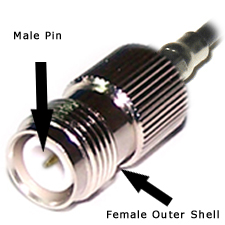 |
Some manufacturers which use TNC connections on some of their Wireless access point products are:
Alvarion
Breezecom
Cisco
EnGenius
Linksys
Orinoco
Proxim
SonicWALL
Wi-LAN
BNC Coax Low-Loss 50 ohm Antenna Cables
The BNC connector (Bayonet Mount locking Mechanism) has been used for years in a variety of applications on both video equipment and radio antenna connections. BNC connectors can be used in 75ohm professional video environments as well as 50ohm radio communication environments. RCA connectors are usually substituted for BNC connectors on consumer electronics. The TNC connector seen above is a threaded version of the BNC connector and generally has better performance in microwave frequencies.
|
BNC Male Connector
|
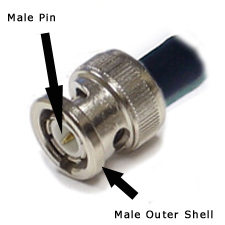 |
|
BNC Female Connector
|
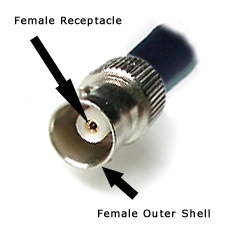 |
N-type Coax Low-Loss 50 ohm Antenna Cables
The N-Type connector was developed back in the 1940's for carrying microwave frequency signals used in military applications. Some of its current uses are in the cable TV industry as well as in the computer industry as antenna cables.
|
N-Type Male Connector
|
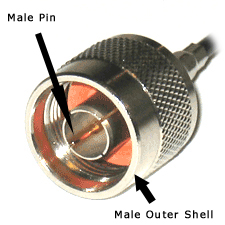 |
|
N-Type Female Connector
|
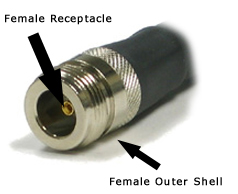 |
Some manufacturers which use N-Type connections on some of their Wireless access point products are:
EnGenius
Wi-LAN